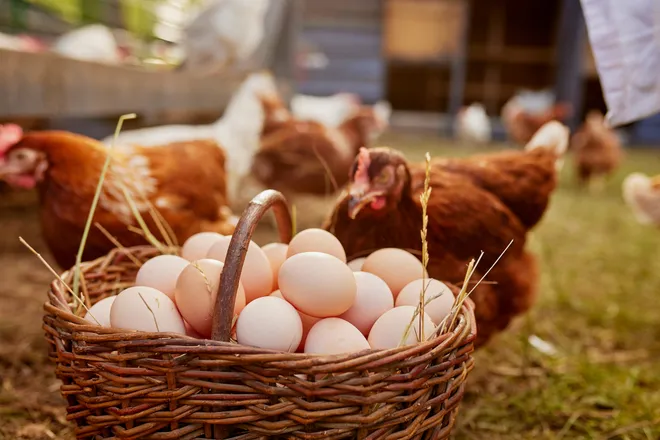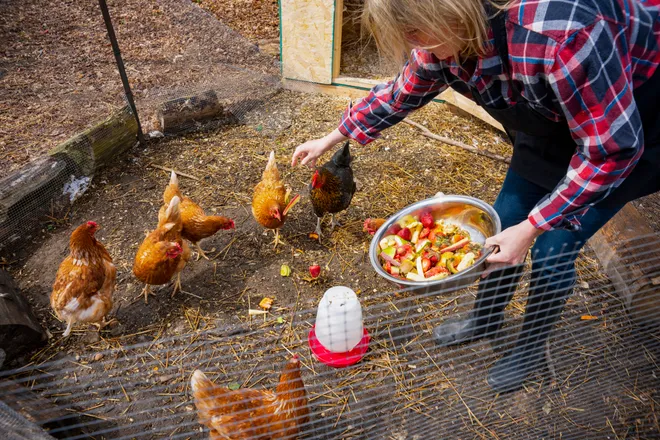Do you own chickens? Here's how to protect your flock from bird flu outbreaks
As concerns about the spread of bird flu continue to grow in the wake of ongoing outbreaks, U.S. officials have are working to keep the virus at bay in commercial poultry and dairy settings.
In a Wednesday update, the U.S. Food and Drug Administration announced that dairy product testing had found remnants of the virus in one out of five samples but none that contained a live virus capable of transmitting the disease. As long as you consume pasteurized dairy products and cook your poultry products to a proper temperature, your mass-produced products continue to be safe, the agency said.
Reports of the virus spreading to other animals outside of birds and cows have left people on edge regardless. Only one case of the virus appearing in a person has been reported despite ongoing testing, said the CDC, and their symptoms were relieved by simple over-the-counter flu medication.
However, the current transmission status, according to the CDC, is "widespread" in wild birds and "sporadic" in poultry flocks, meaning at-home chicken enthusiasts should consider being extra vigilant when looking after their own flocks.
If you keep chickens or other birds, such as waterfowl, on your property, it is best to take some precautions. Here are some tips for keeping your casual flock happy and healthy.

What to know:US to test ground beef in states with dairy cows infected with bird flu
What is bird flu?
Bird flu, also called avian flu, is a contagious infection that spreads among wild birds worldwide and can infect domestic poultry and other animal species. The virus does not usually spread to humans but sporadic infections have been reported. There are several strains all belonging to influenza A-type viruses.
The most common subtypes that may affect humans are A (H5N1), A (H7N9) and A (H9N2), according to the Cleveland Clinic. In humans, symptoms can resemble a typical flu but may advance into more serious respiratory symptoms.
In birds, avian flu is highly contagious and cases can range in severity from mild to highly deadly. Infected birds shed the viruses in their saliva, nasal secretions and feces, meaning other birds can contract the virus through contact with those fluids directly or via contact with a contaminated surface.
Can cats get bird flu:How to protect them and what else to know amid the outbreak
How to protect your backyard chicken flock from bird flu
The biggest risk to backyard chickens and other small domestic flocks is exposure to wild birds. Domesticated birds may become infected with avian influenza A viruses through direct contact with infected waterfowl or poultry through contact with contaminated surfaces.
Some birds, such as ducks, can carry the virus without showing symptoms, meaning it's important to keep your domestic flock secured even if you don't believe there are any sick-looking wild birds around your property.
If you keep chickens or other birds on your property, the CDC suggests these basic precautions:
- Provide ample enclosures and security to ensure your domestic birds do not come into contact with wild birds and other animals.
- Avoid unprotected contact with domestic birds (poultry) that look sick or have died.
- Do not touch surfaces that may be contaminated with saliva, mucous, or feces from wild or domestic birds.
If you believe a member of your flock may be sick or may have come in contact with an infected animal or contaminated service, extra precautions are required. First, look out for these symptoms of highly pathogenic avian influenza viruses:
- Sudden death without clinical signs.
- Lack of energy and appetite.
- Decreased egg production or soft-shelled or misshapen eggs.
- Swelling of head, comb, eyelid, wattles, and hocks.
- Purple discoloration of wattles, comb, and legs.
- Nasal discharge, coughing, and sneezing.
- Incoordination.
- Diarrhea.

If a member of your flock is showing these symptoms or you find dead or ill wild birds on your property, additional precautions need to be put in place to stop the spread. When interacting with sick birds:
- Don’t touch sick or dead birds, their feces or litter, or any surface or water source (for example, ponds, waterers, buckets, pans, troughs) that might be contaminated with their saliva, feces, or any other bodily fluids without wearing personal protective equipment (PPE).
- Wear PPE when around sick or dead birds. (Safety goggles that fit snugly, gloves that are disposable, rubber boots or boot covers, an N95 respirator if available, or, if not available, a well-fitting facemask, coveralls that are disposable and fluid-resistant disposable head cover or hair cover.)
- Depopulate or separate your chickens from their current housing and perform proper cleaning and sterilization. Separate sick birds from healthy ones. Do not mix birds from a potentially infected flock with those who have not been exposed to the viruses.
- As best as possible, during depopulation and while cleaning and disinfecting contaminated premises, avoid stirring up dust and bird waste.
- Do not touch your eyes, mouth, or nose or eat when around or in contact with an infected bird or when wearing PPE.
- Take PPE off immediately after leaving the affected area and before returning to your home. After use, clean or throw away all PPE that was worn in your coop or poultry environment, or around your birds. Shower after removing it and wash the clothing you wore underneath.
- Always wash your hands with soap and water after touching birds, regardless of their health status.
- Change all clothing and equipment after interacting with wild or sick birds before contact with healthy domestic poultry and other pet birds.

Protecting yourself
While bird flu infections in humans are uncommon and unlikely, there are some basic precautions to keep in mind. According to the CDC:
- Avoid direct contact with wild birds and observe them only from a distance, if possible.
- Avoid contact with wild or domestic birds that appear ill or have died and call to report sick or dead birds.
- It is safe to eat properly handled and cooked poultry in the United States. Properly handling and cooking poultry and eggs to an internal temperature of 165 degrees kills bacteria and viruses, including bird flu viruses.
- Seasonal flu vaccination will not prevent infection with bird flu viruses but can reduce the risk of getting sick with human and bird flu viruses at the same time.
- People who become sick within 10 days of exposure to infected birds should isolate at home until they are proven not to have bird flu virus infection and have recovered from their illness. The local or state public health department should be notified and can assist in monitoring and advising when isolation is no longer required.
Disclaimer: The copyright of this article belongs to the original author. Reposting this article is solely for the purpose of information dissemination and does not constitute any investment advice. If there is any infringement, please contact us immediately. We will make corrections or deletions as necessary. Thank you.



